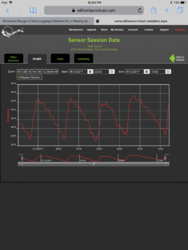I discovered the GARN four years ago and have been excitedly planning and prepping the installation ever since. But yesterday I discovered the Heatmaster G200, thanks to "3fordasho," "hondaracer2oo4" and "Karl_northwind,"
on the post "Heatmaster G200 + 550 gallons storage."
I like the Garn for its ability to eat (dimensionally) huge wood, its high efficiency (gasification), its simplicity, its integral storage, and its horizontal exhaust (way cool!) What I didn't like was its maintenance costs, namely, the annual chemicals to treat such a huge amount of water in an open system; the lower temp water which was going to require a huge WAHX; the cost, especially to bring it into Canada (plus parts and chemicals, as above); and the lack of activity on Youtube - it's been nearly two years since the GARN folks posted their latest video (April 2016). Plus there's that whole fiasco with the anode rods which I feel has only sort of been dealt with (and the solution not really proven). And if Switzer can make a pressurized boiler, why can't Garn?
I'm super excited about this Heatmaster G200! Looks like it can take my 24" wood (is this true?) of which I have cut, split, stacked, and seasoned ~20 cords. It can run without external storage so I can get up and running quickly (but I do want storage later). It runs best at high water temps so that will be great for a furnace/WAHX retrofit and DHW. It takes minimal tube cleaning what with that hand-cranked turbulator-shaker. It can be legally installed indoors (which it most definitely will be!) It can be loaded without smoke in the face just like the Garn. It's efficient like a Garn (I haven't compared the EPA stats though, and wonder if they factored in the clamped-down times or whether the test was full-tilt like with the Garn. Either way, with external storage I'm sure it could be made to be as efficient as a Garn). It is open, but I'd only be treating 200 gallons of water. It's stainless instead of mild steel. And, it's built in my own country, so no cross-border (and depreciated Canadian dollar) hassle. Oh yeah, and it's half the price.
Comments?
on the post "Heatmaster G200 + 550 gallons storage."
I like the Garn for its ability to eat (dimensionally) huge wood, its high efficiency (gasification), its simplicity, its integral storage, and its horizontal exhaust (way cool!) What I didn't like was its maintenance costs, namely, the annual chemicals to treat such a huge amount of water in an open system; the lower temp water which was going to require a huge WAHX; the cost, especially to bring it into Canada (plus parts and chemicals, as above); and the lack of activity on Youtube - it's been nearly two years since the GARN folks posted their latest video (April 2016). Plus there's that whole fiasco with the anode rods which I feel has only sort of been dealt with (and the solution not really proven). And if Switzer can make a pressurized boiler, why can't Garn?
I'm super excited about this Heatmaster G200! Looks like it can take my 24" wood (is this true?) of which I have cut, split, stacked, and seasoned ~20 cords. It can run without external storage so I can get up and running quickly (but I do want storage later). It runs best at high water temps so that will be great for a furnace/WAHX retrofit and DHW. It takes minimal tube cleaning what with that hand-cranked turbulator-shaker. It can be legally installed indoors (which it most definitely will be!) It can be loaded without smoke in the face just like the Garn. It's efficient like a Garn (I haven't compared the EPA stats though, and wonder if they factored in the clamped-down times or whether the test was full-tilt like with the Garn. Either way, with external storage I'm sure it could be made to be as efficient as a Garn). It is open, but I'd only be treating 200 gallons of water. It's stainless instead of mild steel. And, it's built in my own country, so no cross-border (and depreciated Canadian dollar) hassle. Oh yeah, and it's half the price.
Comments?
Last edited:


